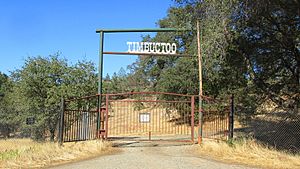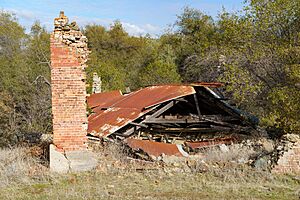Timbuctoo, California facts for kids
Quick facts for kids
Timbuctoo
|
|
|---|---|

Timbuctoo gate.
|
|
| Country | United States |
| State | California |
| County | Yuba County |
| Elevation | 397 ft (121 m) |
| Reference #: | 320 |
Timbuctoo is a small, quiet place in Yuba County, California. It is not a city with its own government. This historic spot sits northwest of Smartsville, about 397 feet (121 meters) above sea level.
Contents
The Story of Timbuctoo
Timbuctoo was once the biggest town in eastern Yuba County. It was built in a great spot near the Yuba River, where gold could be found. The town was also high enough on the hills to stay safe from floods. Timbuctoo was very busy in the 1850s.
How Gold Mining Helped the Town Grow
Gold miners first started the town by looking for gold in the river's sand. In 1854, a new way of mining called hydraulic mining began. This method brought even more success to Timbuctoo. Unlike many mining camps that were just tents, Timbuctoo had enough money to build strong buildings. These were made of wood and brick. The town had stores, a Wells Fargo office, saloons, a church, hotels, and even a theater. The town officially started in 1855. A post office opened there in 1858.
Why is it Called Timbuctoo?
There's a cool story about how Timbuctoo got its name. People say an African American miner, who found gold in the area, named it. He was thought to be from the Timbuktu region in Mali. It's not clear if he named the town himself or if it was named after him. Some stories say he was a freed slave. It's also possible the town was named after older towns called Timbuctoo in New York or New Jersey. Some gold rush travelers might have come from those places.
Why Timbuctoo Shrank
Hydraulic mining brought a lot of money to California. It helped the state and mining companies. But it caused big problems downstream. Huge amounts of dirt and rocks from mining operations ruined farms and riverbanks. It also changed the way rivers flowed in the Sacramento Valley.
The Problem with River Silt
When the river water left the steep mountains, it slowed down in the valley. This caused dirt and silt to settle at the bottom of the Yuba and Feather rivers. The rivers became much shallower. This made it hard for riverboats to travel, which hurt trade with cities like Sacramento and San Francisco.
People in towns like Marysville worried about floods. The shallower rivers made flooding much more likely. Marysville had to build walls called levees to protect itself. This stopped the city from growing much more. Also, valuable farmland was buried under mining waste. Farmers lost their crops and land to floods. Soon, a legal fight began to stop hydraulic mining for good.
The End of Mining and the Town
In 1884, a court in San Francisco decided that hydraulic mining had to stop. This was a win for the farmers. By the time the United States Congress allowed hydraulic mining to start again in 1893, it was too late. The time when a single miner could get rich was over.
Also, a big flood in 1891 had washed away the mining companies' water channels. Now, they could only mine in certain places. Without the gold mining, the town had no way to make money. So, people left, and Timbuctoo became empty. The post office closed in 1883.
Timbuctoo Today
Timbuctoo is now a California Historical Landmark. This means it's an important historical place. Even though some people live in the area, many consider Timbuctoo a ghost town. You can get to the old town site by Timbuctoo Road. This road crosses a stream in two places.
The last building in town was the Stewart Brothers Store/Wells Fargo Office, built in 1855. Its ruins are still there. People used to think gold was hidden inside, so looters tore down its walls. Now, only its brick and stone remains are left, protected by a fence.
The Timbuctoo Cemetery is still used today. It started in 1855 and has about 89 graves, mostly from the late 1800s and early 1900s. It is also fenced to keep it safe.
Timbuctoo was once a small tourist attraction. People knew about its history and wanted to protect it. But even with all this interest, Timbuctoo is an example of a preservation effort that didn't quite work out.




